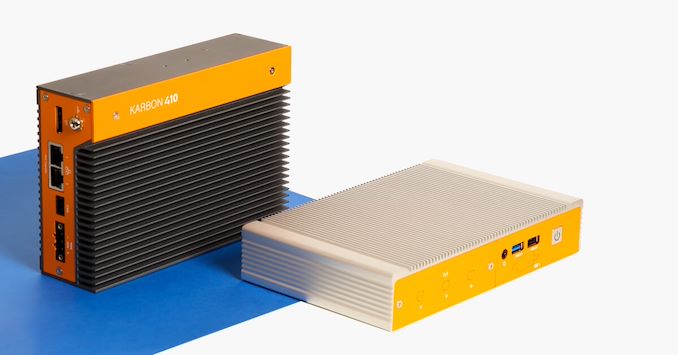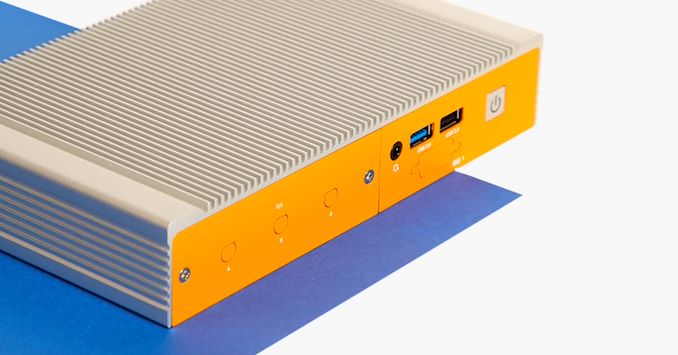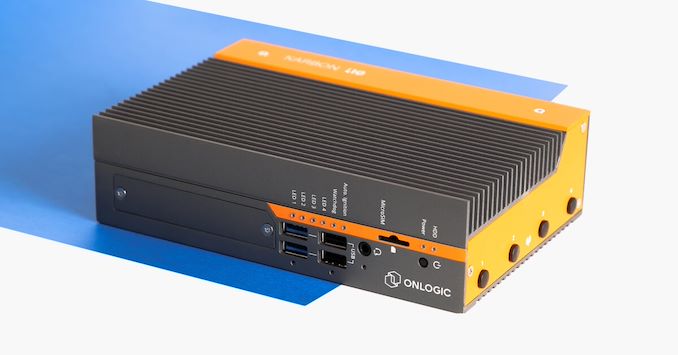OnLogic’s New Fanless Systems Contain Intel's Elkhart Lake (10nm Atom)
by Dr. Ian Cutress on February 1, 2021 7:00 AM EST- Posted in
- CPUs
- Systems
- Intel
- Atom
- Embedded
- IoT
- Tremont
- Jasper Lake
- OnLogic
- Elkhart Lake

Earlier this year Intel indicated that it was launching its new Jasper Lake platform very soon, built on a foundation of 10nm manufacturing with the latest Tremont Atom cores. While Jasper Lake is geared towards consumers and commercial use cases, Intel also has a similar line of processors built for the industrial and IoT markets, also using Tremont on 10nm, called Elkhart Lake. Onlogic, a business built around supplying the industrial and IoT markets, is introducing new fanless designs built around Elkhart Lake.
The four new fanless industrial designs from OnLogic are the Helix 310, Helix 330, Karbon 410, and Karbon 430 – all customizable passively cooled systems for ‘Industry 4.0’. The processors at the heart are all the variants of Elkhart Lake, with the Helix models focusing on dual core Celeron N6211 or quad-core Pentium J6425, while the Karbon models go for dual-core Atom x6211E and quad-core Atom x6425E, the main differentiation of these last two models being the wider thermal support from -40ºC to 70ºC.
OnLogic’s main selling point here is the coupling of its ModBay expansion technology, allowing customers additional connectivity through the M.2 and PCIe slots (effectively making the M.2 a simple PCIe x4 link), with Intel’s Programmable Services Engine, or PSE. Intel’s PSE is described by OnLogic as a dedicated offload engine for IoT built from an Arm Cortex-M7 microcontroller, enabling real-time compute and data tracking. Combined with the compute power of Atom cores, the aim is to provide a complete real-time monitoring and communication system for a wide array of industrial deployments. OnLogic provides solution services enabling custom OS deployments, branding, imaging, fulfilment, and lifecycle support.
The Helix 310 and Helix 330 are built on the same platform but afford different levels of customization. Both models include support for 32 GB of DDR4, at least one M.2 slot, 3 USB 3.2 ports, 3 USB 2.0 ports, three DisplayPort outputs and two COM ports. Where they differ is that the Helix 310 is the base model, featuring 1-2 gigabit Ethernet ports and two M.2 slots with optional 4G/DIO/COM/CAN support, but the Helix 330 uses one of those M.2 slots for dual additional gigabit Ethernet by default.
The Karbon 410 and 430 are similarly on a singular platform together, build for a wider temperature window as well as MIL-STD-810H shock and vibration standards. The base platform has up to 32 GB of DDR4, support for M.2 and mSATA storage, dual gigabit Ethernet, two USB 3.2 ports, two USB 2.0 ports, 1 Display Port, 1 CAN bus, 1 micro-SIM slot, dual M.2 slots, 1 mPCIe slot, and optional 4G/DIO/COM/PoE/TPM. The Karbon 410 is the base model, and the Karbon 430 adds in another pair of M.2 slots, a second micro-SIM slot, and allows for additional networking or USB.
In the last couple of years, when Intel had record demand for its silicon, the main market segments to lose out were the low-end compute market, namely Intel’s Atom portfolio. Now that Intel has sufficient capacity for its demand, along with increased production of its 10nm manufacturing node, it is refocusing its efforts in this embedded compute market with product lines such as Jasper Lake and Elkhart Lake. This also means that OEMs like OnLogic can redesign their portfolio using the latest updates, such as PSE, as well as the latest technologies at low power, enabling a new generation of fanless designs.
OnLogic states that the new Elkhart Lake embedded systems will be available for purchase in Q2, with pricing updates available to customers that get in touch.
Source: OnLogic












18 Comments
View All Comments
psychobriggsy - Monday, February 1, 2021 - link
I like the styling, could do with that in the consumer lines (which could use Van Gogh when that comes out for fanless operation).Operandi - Monday, February 1, 2021 - link
Things that build their purpose into the ID tend to look good. These are pretty rough around the edges and industrial looking though; I guess cause they are industrial...Akassa makes pretty much the home / office equivalent. Anodized black AL, and clean CNC edges on the all surfaces. They looks really sick; I have NUC in one for my HTPC.
Gondalf - Monday, February 1, 2021 - link
Ummm yes they can do these chips now. It is hard to evaluate Intel 10nm capacity, but a standard Intel Fab give 35.000 wafers month. Fab 28 is more like 1.5x a standard Fab so, we can assume Intel have now 45.000/50.000 in Israel, 35.000 at Fab 42 and minimum 35.000 at D1X.So yes 115.000/120.000 wafer starts/month capacity allow even these small chips.
By the way for the first time Intel is over 1.000.000 ws/month between 22 14 and 10nm nodes.
IanCutress - Tuesday, February 2, 2021 - link
How much of those wafer starts/month are on which node though. That's the key question.Gondalf - Thursday, February 4, 2021 - link
My bet : 120.000 ws/month on 10nm (Q2), 880.000 ws/month on 14nm, 22nm and some 65nm ????Another bet for future: Fab42 converted on 7nm in a small time, D1X mod 3 on 7nm from start, Ireland expansion on 7nm. About 10nm capacity, my bet is some or many of actual 14nm lines converted to 10nm during 2021 and 2022, to allow the conversion of Fab 42 to 7nm.
This is allowed by the HUGE purchasing of the latest Nikon scanner, capable of both 14nm and 10nm.
Only ideas, i have not raw data.
DigitalFreak - Monday, February 1, 2021 - link
'Now that Intel has sufficient capacity for its demand' aka AMD is stealing their lunch.m53 - Monday, February 1, 2021 - link
2019 revenue $71.965B2020 revenue $77.867B
I guess, not a good thief. :)
Deicidium369 - Monday, February 1, 2021 - link
Increased revenues by 3/5th of an AMD... terrible thieves indeedAMD did destroy Intel in the ultra high margin Bicycle segment
buufball - Sunday, February 7, 2021 - link
The Intel "sandy-crotch" is strong in this comment section....If 2019 was 71b and 2020 was 77b, thats only 8.4% gain.. and one of intels best years....
AMD was <6b in 2019 and is now >9.5b in 2020... thats a 58% gain buddy.
Nah, no stealing going on here!
jospoortvliet - Thursday, February 11, 2021 - link
Still puts absolute Intel growth of revenue almost 2x that of AMD - at that pace, AMD will not be catching up. AMD will have to keep growth exponential, which is no mean feat. Maybe they will, they're doing well, but at some point Intel is likely to get its act together and I doubt AMD will then still grow with numbers like 50%...